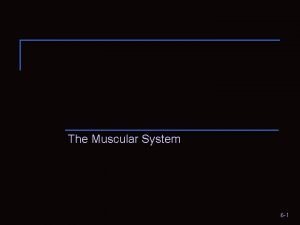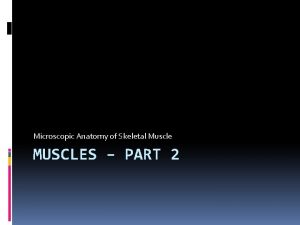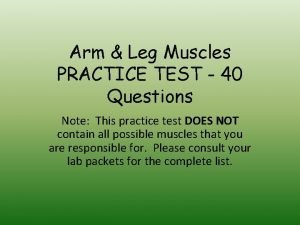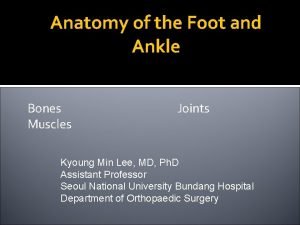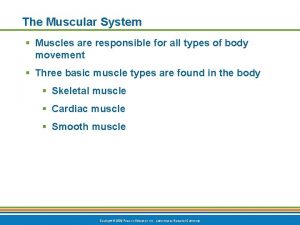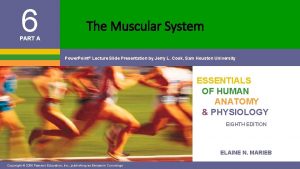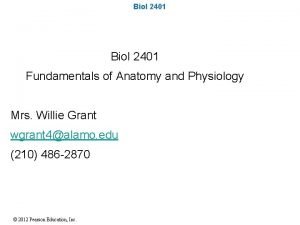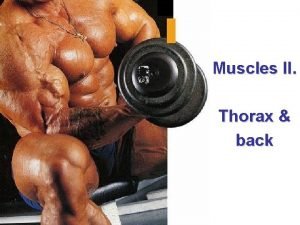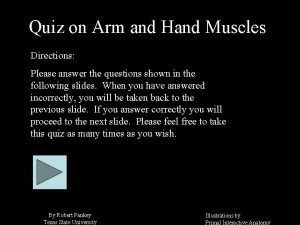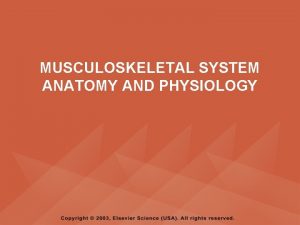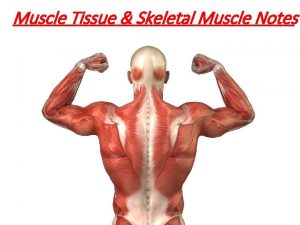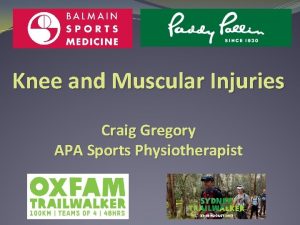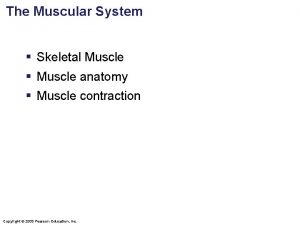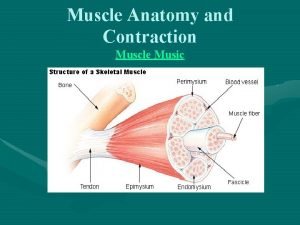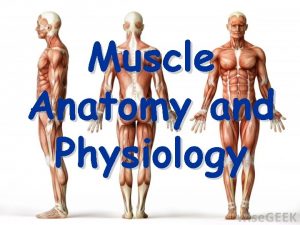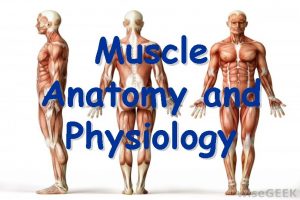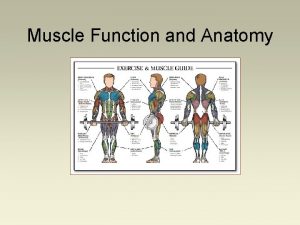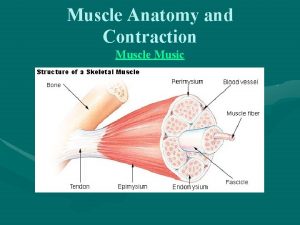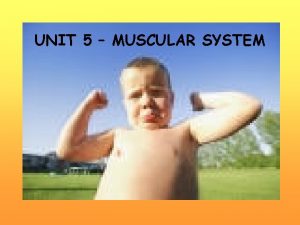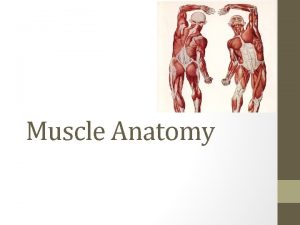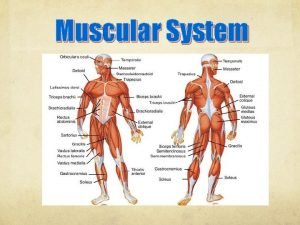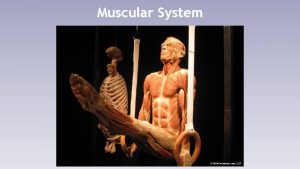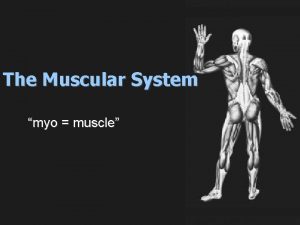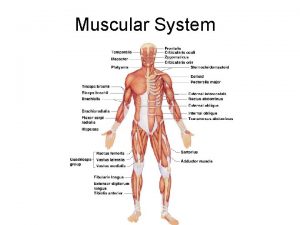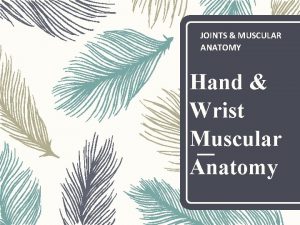Muscular System Unit F Muscle Anatomy Muscular System

















- Slides: 17

Muscular System Unit F

Muscle Anatomy

Muscular System v v Nearly half our weight comes from muscle tissue. There are 650 different muscles in the human body. Muscles give us shape and form. Muscles produce most of our body heat.

Types of Muscles Skeletal muscle. Attached to bone. Striated (striped) appearance. Voluntary. Multinucleated muscle cell bundles (muscle cells = muscle fibers). Sarcolemma = cell membrane. Contract quickly, fatigue easily, can’t maintain contraction or long period of time.

Types of Muscles Cont. Smooth muscle. Visceral (organ) muscle. Found in walls of digestive system, uterus and blood vessels. Cells small and spindle-shaped. Involuntary. Controlled by autonomic nervous system. Act slowly, do not tire easily, can remain contracted for long time.

Types of Muscle Cont. Cardiac muscle. � � Found only in the heart. Striated and branched. Involuntary. Cells are fusedwhen one contracts, they all contract.

Sphincter Special circular muscles in openings of esophagus and stomach, stomach and small intestine, anus, urethra and mouth.

Characteristics of Muscles Contractibility- the ability of a muscle to reduce the distance between the parts of its contents or the space it surrounds. Excitability (irritability)- the ability to respond to certain stimuli by producing impulses. Extensibility- the ability to be stretched Elasticity- ability of muscle to return to its original length when relaxing.

Movement Muscles move bones by pulling on them. As a muscle contracts, it pulls the insertion bone closer to the origin bone. Movement occurs at the joint between the origin and the insertion. Rule: A muscle’s insertion bone moves toward its origin bone. Groups of muscles usually contract to produce a single movement.

Movement Cont. � Motor unit - a motor neuron plus all the muscle fibers it stimulates…. muscle fibers are stimulated in groups � Muscle fatigue - caused by the accumulation of lactic acid in the muscles and the depletion of oxygen

Movement Cont. Oxygen debt - after exercise, the amount of oxygen needed by the muscle to change lactic acid back to glucose. Muscle tone - when muscles are slightly contracted and ready to pull. Diaphragm - done-shaped muscle that separates the abdominal and thoracic cavities, aids in breathing…oxygen capacity key to muscle use

Three Main Functions 1. Body movement. 2. Body form and shape. (Posture) 3. Body heat and maintaining temperature.

Disorders and Related Terminology Atrophy- wasting away of muscles (i. e. wearing a cast causes atrophy from not using the muscle) Hypertrophy- an increase in the size of the muscle cell (i. e. body builders suffer from hypertophy) Strain - tear in the muscle resulting from excessive use. Bleeding inside the muscle can result in pain and swelling. Rx – Ice to reduce swelling

Muscle spasm (cramp)- sustained contraction of the muscle, usually because of overuse. Myalgia- muscle pain. Tendonitis - inflammation of a tendon.

Myasthenia Gravis Autoimmune disorder- immune system attacks healthy tissue Symptoms Voluntary muscle weakness Difficulty swallowing or chewing Paralysis Treatment Plenty of rest Avoid stress and heat Medications There is no cure http: //www. youtube. com/watch? v=mt 0 ef. T 2 xk 2 Y

Muscular Dystrophy Muscle cells deteriorate Most common type is Duchenne’s which is a birth defect Symptoms Muscle weakness that progresses Falls Delayed walking No treatment managing symptoms only

Tetanus Also called lockjaw Caused by toxin entering through puncture wound Symptoms Spasms of voluntary muscles that start in jaw and move throughout body Treatment Antibiotics Rest Tetanus vaccine to prevent http: //www. youtube. com/watch? v=AX 5 K_uvh. L 6 w http: //www. youtube. com/watch? v=l. CZxff. Nc. Fxw
 Difference between strength and endurance
Difference between strength and endurance Fusiform
Fusiform What muscle fibers run in circles around your eye
What muscle fibers run in circles around your eye Chapter 6 the muscular system figure 6-9
Chapter 6 the muscular system figure 6-9 Microscopic anatomy of skeletal muscles
Microscopic anatomy of skeletal muscles Leg muscles names
Leg muscles names Muscle anatomy
Muscle anatomy Microscopic anatomy of skeletal muscle figure 6-2
Microscopic anatomy of skeletal muscle figure 6-2 Dorsifelxion
Dorsifelxion Microscopic anatomy of skeletal muscle
Microscopic anatomy of skeletal muscle Muscle anatomy
Muscle anatomy Pars sternalis diaphragmatis
Pars sternalis diaphragmatis Muscles of hand
Muscles of hand Pyramid muscle anatomy
Pyramid muscle anatomy Skeletal muscle
Skeletal muscle Knee muscle anatomy
Knee muscle anatomy Muscle of the forearm
Muscle of the forearm Anatomy and physiology unit 7 cardiovascular system
Anatomy and physiology unit 7 cardiovascular system



